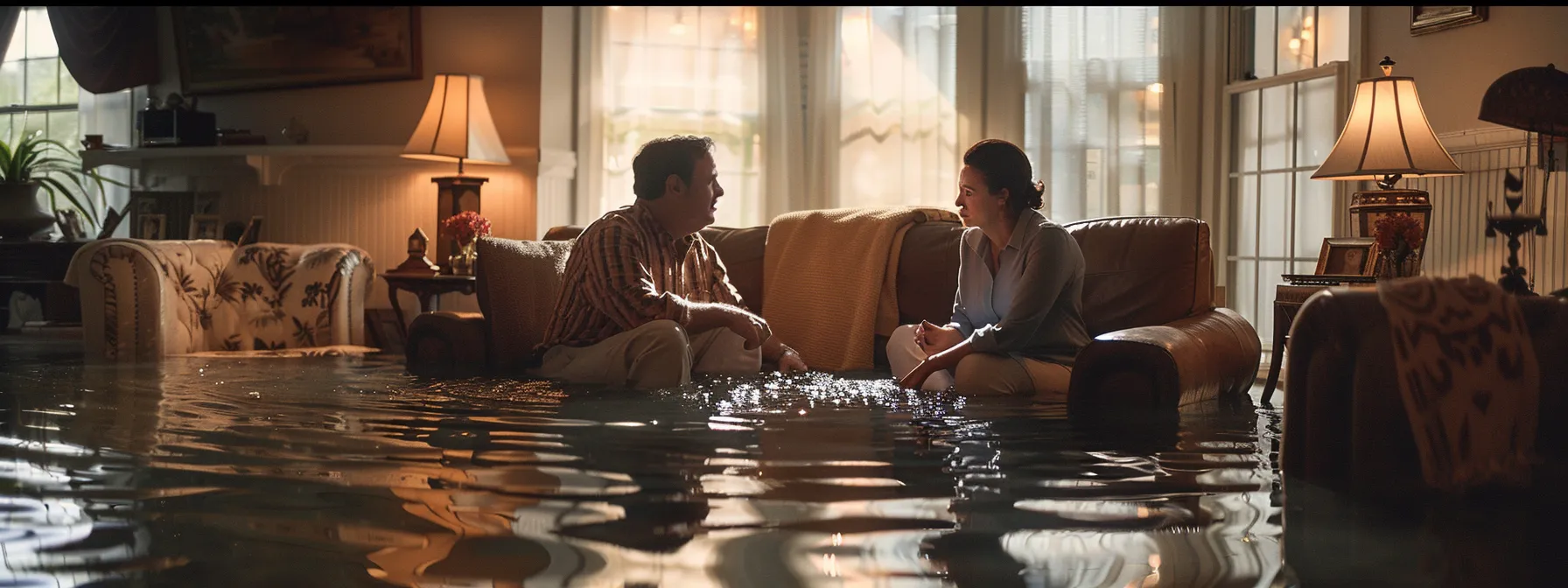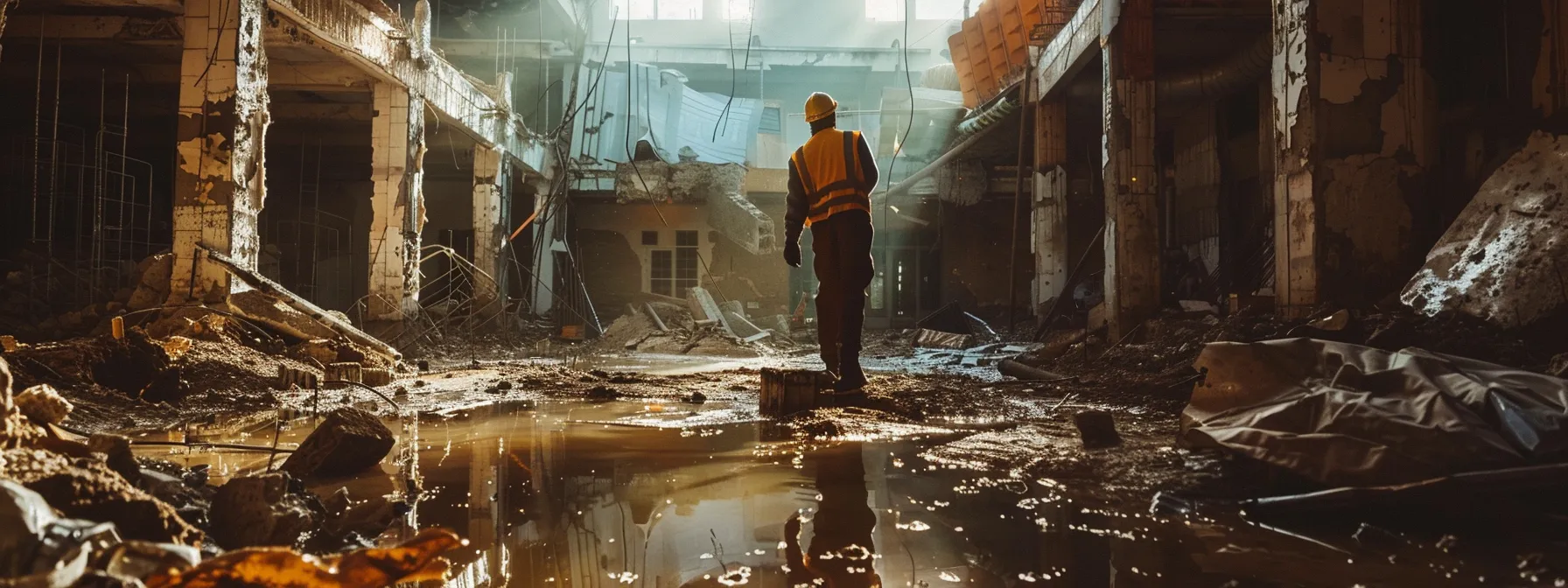Understanding Flood Zone AE: Risks and Regulations
Navigating the waters of flood zone classification can mean the difference between tranquility and financial turmoil for homeowners. Flood Zone AE, designated by the Federal Emergency Management Agency (FEMA), signals areas at high risk for flooding, inevitably influencing both home insurance premiums and peace of mind. Understanding your standing in such zones dictates the insurance strategies you must adopt to protect your investment against the unpredictable nature of water.
In this article, you’ll uncover the intricacies of Flood Zone AE, from determining your risk to navigating the requirements and regulations set forth for your safety and security. Discover actionable steps you can take to mitigate these risks, potentially saving yourself from the rising tide of high insurance costs.
What Is Flood Zone AE?
If you’ve discovered your property sits in Flood Zone AE, you’re navigating a specific regulatory landscape governed by the National Flood Insurance Program. I faced these same concerns when i bought a home in flood zone AE more than a decade ago. Zone AE designates areas at a high risk for flooding, defined by the 100-year floodplain, where there is at least a one percent annual chance of experiencing a flood event.
Understanding the intricacies of Flood Zone AE is critical not only for your peace of mind but also for satisfying the demands of flood control requirements and insurance obligations. A property within this zone is subject to specific rules that determine building standards and insurance premiums, leading to a marked impact on your investment. Familiarizing yourself with the Flood Insurance Rate Map (FIRM) will guide you through the required precautions and adjustments needed to mitigate risk and ensure compliance.
Understanding the Basics of Flood Zone AE
Grasping the essentials of Flood Zone AE hinges on recognizing the elevation requirements that come with the territory. Here, your property is expected to comply with specific elevation standards to minimize the hazard of flood damage. These standards significantly influence your insurance policy, dictating the flood insurance rates you’ll encounter.
Your awareness of how Flood Zone AE affects your property extends to the implications for your insurance coverage. It’s mandated that homes within this high-risk zone carry a flood insurance policy, which necessitates a clear understanding of the terms and cost—knowledge that ultimately arms you in safeguarding your property against unforeseen losses.
Why Properties in Flood Zone AE Require Attention
Properties situated in Flood Zone AE fall into what’s known as a Special Flood Hazard Area, which calls for heightened scrutiny from both emergency management officials and insurance providers. If you have a mortgage from a federally regulated lender on such a property, you’re legally required to purchase flood insurance, a stipulation that underscores the serious risk of water damage inherent to these zones.
Access to precise and up-to-date information is essential for homeowners in these areas. Understanding the specific emergency management procedures and building codes for Flood Zone AE is crucial to protect your investment and adhere to the regulatory framework that governs properties at high risk for flooding.
The Risks Associated With Living in Flood Zone AE
When contemplating the purchase or ownership of a property located in Flood Zone AE, it’s essential to evaluate the underlying flood risk. Your insurance policy hinges on this risk rating, demanding a thorough investigation of historical data to gauge the likelihood and potential severity of flooding. Data isn’t merely a collection of statistics—it’s a narrative of past events that can forecast future occurrences, guiding your decision-making process.
As you acquaint yourself with the history of flooding in AE zones, consider how these patterns may influence your property‘s safety and the ongoing cost of its protection, both of which have real consequences for your expenses and employment. Addressing these concerns upfront aids in crafting a robust plan to safeguard what is often one’s most valued asset.
Evaluating the Flood Risk in Flood Zone AE
When you’re determining the flood risk associated with living in Flood Zone AE, closely scrutinizing local water bodies, like streams and drainage systems, is crucial. The dynamics of these natural and man-made features play a significant role in your property‘s vulnerability to flooding, with zoning decisions and development patterns often affecting their efficiency and flood risk.
Before making any decisions, investigate how well-equipped your community is in terms of accessibility to reliable information and disaster recovery resources. Your safety and the protection of your property during a flood hinge on prompt alerts and a well-executed emergency plan that can mitigate the severe consequences of such events.
|
Factor |
Impact on Flood Risk |
|---|---|
|
Proximity to Streams and Drainage Systems |
Increases potential for water overflow and property damage. |
|
Local Zoning and Development Patterns |
Influences water flow and can exacerbate flooding conditions. |
|
Community Accessibility and Emergency Plans |
Essential for minimizing damage and ensuring quick disaster recovery. |
Historical Flood Events in AE Zones
Reviewing historical flood events in AE zones, it’s imperative to keep in mind the infrastructural elements like levees and dams. These structures, designed to protect against rising waters from lakes and rivers, can inadvertently affect the flood risk of a surrounding area, especially if maintenance lapses or construction disrupts natural water paths.
|
Infrastructure |
Impact on Historical Flood Events |
|---|---|
|
Levees and Dams |
Can mitigate or inadvertently increase flood impact depending on maintenance and construction quality. |
|
Natural Water Bodies (Lakes, Rivers) |
Source of flooding; protection level influenced by surrounding infrastructure and meteorological events. |
Securing a license for property modifications in AE zones often necessitates an examination of past flood events, particularly along the coast. This due diligence is paramount, as it ensures new buildings or renovations consider historical patterns to prevent compounding current flood risks with inadequate or ill-suited construction practices.
How to Determine if You’re in Flood Zone AE
Determining your property‘s risk of coastal flooding means identifying whether you’re in Flood Zone AE, a task that involves utilizing the right tools and resources. As a critical step for any homeowner or community member, pinpointing the exact flood zone of your property should never be a guessing game. Fortunately, the FAQ sections on government and insurance websites, along with interactive tools, provide an alluvial fan of resources designed to clarify your flood zone status with precision.
Ensuring accurate identification of your flood zone protects the safety and value of your property, and guides the necessary precautions you must take against the high risk of flooding that AE zones present.
Tools and Resources for Identifying AE Zones
To accurately pinpoint your inclusion in Flood Zone AE, you can employ a host of digital tools. For instance, the FEMA Flood Map Service Center offers an interactive map where you can observe your property in relation to the established flood zones, including those at or below sea level, which are prone to significant flood risks.
Important documents like the Elevation Certificate provide detailed information on your home’s height relative to flood zones, aiding in the assessment of your risk level and insurance needs. This certificate factors in the velocity of water flow, proximity to major water bodies like rivers, and even the protective role of natural barriers like trees: Elevation Certificate.
|
Document/Tool |
Usefulness for Identifying Flood Zone AE |
|---|---|
|
FEMA Flood Map Service Center |
Interactive map showing property location relative to flood zones at or below sea level. |
|
Elevation Certificate |
Establishes property elevation, considering velocity of floodwaters and proximity to rivers and trees. |
The Importance of Accurate Flood Zone Identification
Knowing with certainty whether your property lies within Flood Zone AE directly informs your flood insurance premiums and coverage requirements. A precise evaluation ultimately ensures you’re neither inadequately insured in a disaster nor overpaying for unnecessary protection.
Without accurate flood zone identification, the risk is twofold: construction or remodeling may not meet the stringent regulations imposed by flood zone designations, and insurance claims, should flooding occur, could face complications or denials, compromising your financial stability.
Flood Insurance Requirements in Flood Zone AE
Stepping into Flood Zone AE comes with a distinct set of requirements and responsibilities for homeowners. Paramount among these is understanding the intricacies of flood insurance mandates set forth by FEMA.
As you prepare to secure coverage, knowledge is your most valuable asset in navigating the marketplace for flood insurance policies that cater to the unique demands of AE zones. Banks, too, have their part to play, often holding flood insurance as a condition for mortgage approval within these high-risk areas.
It’s essential to discern just how much coverage aligns with your needs, safeguarding against overinsurance while avoiding the pitfalls of underinsurance. Let’s look at what’s expected, how to find the right policy, and the specifics of what your bank might require for your treasured home in Flood Zone AE.
Understanding FEMA’s Insurance Mandates for AE Zones
Confronting the obligations of Flood Zone AE, you must heed FEMA’s insurance mandates, which dictate coverage minimums essential for homeowners in these high-risk areas. Grappling with these requirements, it’s imperative for you to ascertain the minimum level of flood insurance necessary to satisfy federal mandates and shield your home from financial ruin due to flood damage.
Embarking on the journey of securing your home, you’ll find that FEMA’s guidelines serve as the backbone for the policies offered by insurers. This means that as a homeowner in Flood Zone AE, you will need to procure a policy that meets or exceeds the stipulated minimum coverage, ensuring full compliance with federal regulations and providing ample protection for your property.
How to Shop for Flood Insurance in Flood Zone AE
Shopping for flood insurance in Flood Zone AE starts with evaluating insurers who offer policies that specifically cater to the needs of high-risk flood areas. Consider the financial stability and claim responsiveness of these providers, as they will be your anchor in weathering the storm.
Your search for flood insurance should involve a careful comparison of coverage limits, deductibles, and exclusions to ensure your policy fits your specific needs. Reach out to multiple insurance agents and request quotes to secure a comprehensive view of your options:
|
Insurance Provider |
Coverage Limits |
Deductibles |
Exclusions |
|---|---|---|---|
|
Provider A |
Up to $250,000 |
$1,000 |
Earth movement, sewer backup |
|
Provider B |
Up to $500,000 |
$2,500 |
Landscaping, currency loss |
|
Provider C |
Varies by policy |
Customizable |
Personal property, mold |
Bank Requirements for Flood Zone AE
As a homeowner in Flood Zone AE, you’re likely aware that banks have their own conditions when issuing mortgages for properties in high-risk flood areas. Your lender will typically insist on proof of flood insurance before finalizing your home loan, confirming adherence to federal regulations and their interest in protecting the asset.
Keep in mind, banks may also require that the amount of flood insurance at least equals the outstanding balance of your mortgage, or the maximum coverage available from the National Flood Insurance Program. Ensure your policy fulfills these criteria to maintain good standing with your lender and avoid potential roadblocks:
|
Requirement |
Explanation |
|---|---|
|
Proof of Insurance |
Documentation showing valid flood insurance policy is in place. |
|
Minimum Coverage Amount |
Insurance must cover the lowest of either the outstanding mortgage balance or the NFIP coverage limit. |
How Much Flood Insurance Do You Need in Flood Zone AE
Ascertaining the amount of flood insurance required in Flood Zone AE means carefully balancing your property‘s value with the potential costs of repair or replacement following a flooding event. You need to align your coverage with the actual cash value or replacement cost of your property, reflecting its dimension, materials, and location within the flood zone.
Consulting with an insurance specialist is paramount to determining the right level of coverage for your home:
|
Value Factor |
Role in Coverage |
|---|---|
|
Property Size and Composition |
Defines the baseline of potential repair costs post-flooding. |
|
Property Location in AE Zone |
Indicates the risk level and informs the coverage amount. |
|
Actual Cash Value/Replacement Cost |
Guides the policyholder on the appropriate financial protection. |
They’ll factor in not only the flood risk but also local building costs and the specifics of your home, ensuring that your coverage offers the security that mirrors the risk: adequate without excess, managed with prudence rather than fear.
Building and Construction Regulations in Flood Zone AE
Embarking on building or renovating in Flood Zone AE requires a deep dive into a complex web of local and federal building codes. As a property owner, you need to ensure the foundation of your construction project is laid on the rock-solid ground of regulation compliance. It’s not just about erecting structures; it’s about crafting resilient homes that stand strong against the relentless challenge of floods. Knowledge here acts as your greatest ally, guiding you through the best practices for building in AE zones.
Beyond compliance, there’s an opportunity to potentially redefine your property‘s risk status through a Letter of Map Amendment (LOMA), a process which, if successful, transforms your flood zone classification, leading to possible insurance premium reductions and expanded construction freedom.
Navigating Local and Federal Building Codes
Embarking on construction or renovation in Flood Zone AE demands a clear understanding of both local building ordinances and federal regulations. You’re required to familiarize yourself with community-specific codes that address flood resilience and meet the more general, but stringent, guidelines laid out by the Federal Emergency Management Agency (FEMA):
Your role in adhering to these codes is pivotal in ensuring both the safety of your home and its compliance with legal standards. Local regulations may dictate specific construction materials and elevated platforms, while FEMA provides the overarching framework for floodplain management: ensuring your property stands up to potential flood challenges:
|
Regulatory Body |
Key Compliance Areas |
|---|---|
|
Local Municipality |
Material selection, elevation requirements, utility placement. |
|
FEMA |
Floodplain management, base flood elevation, insurance implications. |
Best Practices for Construction in AE Zones
When planning construction in Flood Zone AE, prioritizing elevation is non-negotiable. Your structure must be built above the base flood elevation (BFE) specified for your area to minimize the risk of floodwater damage.
Selecting construction materials that can withstand the rigors of flooding should guide your choices. Ensure that your design incorporates elements like flood-resistant insulation and electrical systems elevated above the BFE to protect your property during a flood:
|
Construction Feature |
Flood Resilience Consideration |
|---|---|
|
Elevation |
Built above local BFE to reduce flood damage potential. |
|
Materials |
Use of flood-resistant substances to enhance durability. |
|
Utility Systems |
Electrical and insulation systems elevated above BFE for damage prevention. |
Building Out of Flood Zone AE
Exploring the potential of a Letter of Map Amendment (LOMA) could alter your property‘s classification within Flood Zone AE. Through this process, you have the opportunity to challenge the current flood zone designation of your property, possibly leading to a reclassification to a zone with lesser risk such as Flood Zone X. this process was able to save me thousands of dollars when i diid it more than a decade ago.
Securing LOMA approval means a significant reduction in insurance premiums and greater flexibility in building options:
|
LOMA Process Step |
Expected Homeowner Action |
|---|---|
|
Engage Licensed Surveyor or Engineer |
Complete and provide Elevation Certificate. |
|
Submit LOMA Application to FEMA |
Fill out relevant forms and compile necessary documentation. |
|
Property Reclassification |
Adjust development and insurance plans according to new zone. |
Collaboration with floodplain managers and construction experts can aid you in meeting or exceeding regulatory standards, ultimately securing your property‘s long-term safety and value. Knowing what structural or property elevation modifications can be leveraged to your advantage is key to mitigating the risks that come with living in Flood Zone AE.
Letter of Map Amendment
Embarking on a Letter of Map Amendment (LOMA) offers a potential shift in your property‘s flood zone from AE to a lower-risk category. This pivotal move can manifest in tangible savings on flood insurance as well as increased control over property development and use, reflecting a more accurate flood risk assessment.
To navigate a LOMA successfully, you must gather substantial evidence, such as elevation data, to demonstrate your property‘s placement above the base flood elevation. The accurate, detailed submission to FEMA, if validated, unlocks the opportunity to recast your property‘s flood standing, yielding financial and regulatory benefits for the proactive homeowner.
Mitigation Strategies to Reduce Flood Risk in AE Zones
Living in Flood Zone AE heightens the necessity for proactive measures to safeguard your property. As extreme weather events become more commonplace, the advent of innovative flood barriers and other active mitigation measures can provide substantial defenses against the deluge. Participation in broad community and governmental initiatives for flood prevention enhances the overall resilience of your neighborhood.
Together, these individual actions and collective efforts create a formidable barrier, diminishing the exposure of your home to the ravages of floodwaters and securing the future stability of your cherished investment.
Implementing Flood Barriers and Other Mitigation Measures
Fortifying your home against floods in AE zones involves investing in both temporary and permanent barriers. Temporary solutions like sandbags and water-filled tubes can be deployed swiftly in anticipation of a flood, while permanent fixtures, such as retaining walls and foundation waterproofing, offer enduring resistance to floodwaters.
While evaluating mitigation measures, consider the efficacy of wet floodproofing techniques: allowing certain parts of your property to flood in order to prevent structural damage. These methods, along with dry floodproofing—sealing your building to prevent floodwaters from entering—enhance your home’s resilience:
|
Mitigation Measure |
Type |
Effectiveness |
|---|---|---|
|
Sandbags/Water-filled Tubes |
Temporary |
Quick deployment, suitable for immediate response. |
|
Retaining Walls |
Permanent |
Long-term barrier, reducing erosion and water overflow. |
|
Foundation Waterproofing |
Permanent |
Prevents seepage, protecting structural integrity. |
|
Wet Floodproofing |
Permanent |
Manages water entry and exit to lessen damage. |
|
Dry Floodproofing |
Permanent |
Seals building, barring floodwaters from entering. |
Community and Government Initiatives for Flood Prevention
Encouraging community involvement and integrating government support, localities in Flood Zone AE often spearhead initiatives aimed at bolstering area-wide flood prevention. This multi-tiered approach may include the establishment of green infrastructure, such as rain gardens and permeable pavements, to naturally absorb excess water and diminish runoff during heavy rains.
Your understanding of these initiatives can assist you in aligning your home’s individual mitigation efforts with broader, more strategic plans. These strategies, underscored by governmental grants and community action programs, work collectively to strengthen your neighborhood’s defense against the destructive power of flooding, ensuring a unified front in flood prevention and management.
Frequently Asked Questions
What defines a property as being in Flood Zone AE?
Flood Zone AE is defined by a 1% annual chance of flooding and the potential for larger hazards during a 100-year flood event.
What potential dangers come with living in flood zone AE?
Living in flood zone AE means a high risk for flooding, which can lead to property damage, costly insurance premiums, and potential loss of property value.
How can I find out if my home lies within Flood Zone AE?
To determine if your home is in Flood Zone AE, check the FEMA Flood Map Service Center or consult your local government’s floodplain manager for the latest flood mapping information.
Is purchasing flood insurance mandatory for flood zone AE residents?
Yes, if you have a mortgage from a federally regulated lender and your home is in flood zone AE, flood insurance is typically required.
What building codes must I follow in a flood zone AE area?
In AE flood zones, adhere to local building codes requiring elevated structures, secure anchoring, flood-resistant materials, and utilities protection; each municipality varies, so consult your local ordinances for specifics.
Conclusion
Understanding the specifics of Flood Zone AE is imperative for homeowners since it outlines the high risk of flooding and dictates stringent building standards and insurance requirements. Familiarity with local and federal regulations ensures that your property complies with safety norms and yields informed decisions on appropriate flood insurance coverage.
By considering a Letter of Map Amendment, homeowners have the potential to reclassify their property to a lower-risk flood zone, leading to insurance savings and greater building flexibility.
Proactive mitigation strategies and engagement with community initiatives significantly bolster a property‘s resilience against flooding, establishing a secure environment that upholds the value and safety of the home.
Information contained on this page is provided by an independent third-party content provider. This website make no warranties or representations in connection therewith. If you are affiliated with this page and would like it removed please contact editor @producerpress.com


.png?width=1280&height=720&name=NEW%20Thumbnail%20(3).png)












